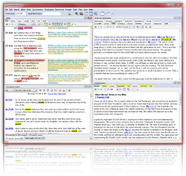Ain
A'in (Hebrew A'yin, עיַן, a fountain) signifies literally an eye, and also, in the simple but vivid imagery of the East, a spring, or natural burst of living water, always contradistinguished from the well or tank of artificial formation, and which latter is designated by the word "Beer" (בּאֵר) or "Bor" (בּאר and בּוֹר). Ain still retains its ancient and double meaning in the Arabic 'Ain. Such living springs abound in Palestine even more than in other mountainous districts, and, apart from their natural value in a hot climate, form one of the most remarkable features of the country. Prof. Stanley (Palest. p. 147, 509) has called attention to the accurate and persistent use of the word in the original text of the Bible, and has well expressed the inconvenience arising from the confusion in the Auth. Vers. of words and things so radically distinct as Ain and Beer. The importance of distinguishing between the two is illustrated by Ex 15:27, in which the word Ainoth (translated "wells") is used for the springs of fresh water at Elim, although the rocky soil of that place excludes the supposition of dug wells.
Ain oftenest occurs in combination with other words, forming the names of definite localities: these will be found under EN- (q.v.), as En-gedi, En- gannim, etc. It occurs alone in two cases. SEE FOUNTAIN.
1. (Sept. at Jos 21:16, Α᾿σά, at 1Ch 4:32, ῎Ην; elsewhere it blends as a prefix with the following names, Ε᾿ρ-εμώθ, Ε᾿ρ- εμών.) A city at first assigned to the tribe of Judah, on its southern border (Jos 15:32), but afterward to Simeon (Jos 19:7; 1Ch 4:32). In all these passages it is mentioned as adjoining Remmon or Rimmon (q.v.), and it seems to be the EN-RIMMON SEE N- RIMMON (q.v.) of Ne 11:29. It was one of the Levitical cities (Jos 21:16). Reland (Palaest. p. 554, 625) thinks it the same with the Betane (Βετάνη) of Judith 1:9, and the Bethanin (Βηθανίν) located by Eusebius (Onomast. s.v. Α᾿ρί, i e. Α᾿ϊvν) at four Roman miles from Hebron. But these are rather the Bethanoth (q.v.) of Jos 15:59. Dr. Robinson conjectures it may have been the same with the modern village el-Ghuwein, the ruins of which he saw in a valley a short distance to the right of the road a few hours south of Hebron (Researches, 2, 625). But this again is probably the Anim (q.v.) of Jos 15:50. The margin of our Bibles identifies this Ain with the Ashan of Jos 15:42, but in 1Ch 4:32 both are mentioned. In the list of priests' cities in 1Ch 6:59, Ashan (q.v.) appears to take the place of Ain.
2. (With the art., חָעִיַן, Ha-A'yin.); One of the landmarks on the northern or eastern boundary of Palestine as described by Moses (Nu 34:11), near the lake Gennesareth, adjoining Shephan, and apparently mentioned to define the position of Riblah, viz. "on the east side of 'the spring'" (Sept. ἐπί πηγάς). But the ambiguous phrase מַקֶּדֶם לָעִיַן (literally, from the east as to the spring), rather refers directly to the boundary as extending in general terms easterly to Ain, in the direction of Riblah (q.v.). By Jerome, in the Vulgate, it is rendered contra fontem Daphnin, meaning the spring which rose in the celebrated grove of Daphne dedicated to Apollo and Diana at Antioch. Riblah having been lately, with much probability, identified (Robinson, Research. new ed. 3, 542-6; Porter, 2:335) with a place of the same name on the north-east slopes of the Lebanon range, "the spring" of the text is probably the modern Ain, in Coele-Syria, between the Orontes and the Litany (Bibliotheca Sacra, 1847, p. 405, 408); so called from a large fountain of the same name a little to the north of the village, which "is strong enough to drive several mills, and about it are heavy blocks of hewn stone of a very antique appearance" (ibid. 1848, p. 698). Dr. Robinson, however, thinks it is rather an appellative, and refers to the fountain of the Orontes still farther south- west of Riblah (new ed. of Researches, 3, 534).

